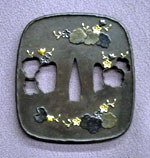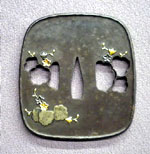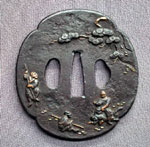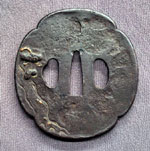1) �\ �ԋ˂̐} ���� �ԏ錬���t
Design: Paulownia flower |
 |
 |
2) ���@�F�c 81.0�~��75.0�~����4.5 (mm)�@
����F�˂͍ЉЂ��������Ƃ��čl�����A�܂��A�����̐����Ƃ����P�������ނƂ���_��������Ă���B
���̂��Ƃ�����A�e��Ƌ��ɁA�R������䏊�Ƃ��čc���ł͎g�p����Ă���B
�����ɒb����ꂽ�n�S�A���E��E�ԓ��ۛƂ̏��Ȕz�u�A����ɍ��E�̟C���͋˂̉e���������ɂĂ܂Ƃ�
�グ���Ă���A���˂̖��H�u�ԏ錬���t�v�̍�Ǝv����D��Ȗ��\�ł���B�]�ˎ��㒆��(1785�N��)�B
�u���B����A���ė����\�vPart�U(�ɔg�x�F���A1971�N���s)���ځB(P.65)
Design: Paulownia flower
Kiri, Paulownia tree is regarded as a sacred tree which protect from disaster,
and phoenix
that appears only in peaceful period dwells in it. In the Imperial family,
it has been used as a noble family crest from old time as well as Kiku-mon,
chrysanthemum crest.
It is also known as a family crest of great Samurai, Toyotomi Hideyoshi
who unified
Japan in 16th century.
It is attributed to Sekijoken Motozane who is famous maker in Mito.
The fine forged iron plate inlaid with gold, silver and Shakudo (alloy
of gold with copper etc.)
is an excellent work. Edo period, circa 1785.
Illustrated on �gTsuba, Coming back from Europe�h Part�U, written by Inami Tomihiko in 1971. (P.65)
|
2) �\ �ؐM�҂�����})
Design of Kanshin no mata-kuguri |
 |
 |
2) �\ �ؐM�҂�����}
�c83.0�~��77.5�~����5.0(mm)
�ؐM�͒����E�O������(�O200�N��)�Ɋ��̓V������Ɍ��т��������叫�R�ł���B
�{���́A�ؐM���N����ɖ������ɗ��܂�A�u�҂�����������Ă��v�Ƃ���
���ɁA�ς��E�тȂ���҂������������}�����Ƃ����̎��B
��u�̂���҂͖ڐ�̏����ɂ͔E�ς������đ���Ȃ��Ƃ����L���ȌP���ł���B
�]�ˎ��㒆���B
Design of Kanshin no mata-kuguri, Kanshin�fs patience,
is a famous historical event in China.
Kanshin is the great general who was employed by Ryuho
(the first emperor of former Han dynasty, B.C.202.).
In his youth, ruffians tried to pick a quarrel with him on a street. One ruffian said
"Crawl between my legs if you want to walk along this street".
He got angry and tried to kill the ruffians using own sword.
But he tried to calm oneself down, crawled between the legs with patience.
His behavior shows �gThinking about the entirety of something without being bogged down
by its particulars�h. This is a precept for a person who has high ambitious. 18th century.
|
4) �ڊ� �˖�O�o�}�@���� �Ë��H
Design: Paulownia crest with 5-7-5 flowers by Ko-kinko which mean metal worker in 16th century. |
 |
 |
���@�F��) �c17.0�~��35.0 (mm)�@�E) �c17.0�~��34.5 (mm)
����F�˖�͑��킠�邪�A�{��̗l��3���̗t�̏�ɁA���E�Ɋe5������7�̋˂̉Ԃ�z����
�䏊���u���̋ˁv�ƌĂԁB��i�ŌÕ��ȍ앿�ł���A���̉A�z��������𗠕t����B
�˂͋e�Ɠ��l�ɍc���Ő����Ƃ��Ĉ��p���ꂽ���M�ȐA���ł���B�܂��A���K�Ƃ��ċ˖�͂��т���
�V�c�Ƃ��珫�R�Ɠ��ւƉ�������A���m�ɂƂ��Ă͑�ςȖ��_�Ƃ��ꂽ�B
�˖�͖L�b�G�g�Ɉ�����A�L�b�Ƃ̖䏊�Ƃ���Ă���B
����������(16���I)�B�ۑ��Ӓ菑�t�B
Design: Paulownia crest with 5-7-5 flowers by Ko-kinko which meanmetal
worker in 16th century.
We can see In-yo-kon on the back side which is typical old Menuki style.
This kind of design is called Go (5) Shichi (7) no Kiri.
The imperial family bestowed these crests on the shogunate family in each
period as
a token of allegiance. This customary plays an important part as
a diplomatic tool in those days, and it is a very honor to receive it for
Samurai.
It is also known as family crest of Toyotomi Hideyoshi who governed all of Japan
in Momoyama period. 16th century. Hozon certificate paper.
|